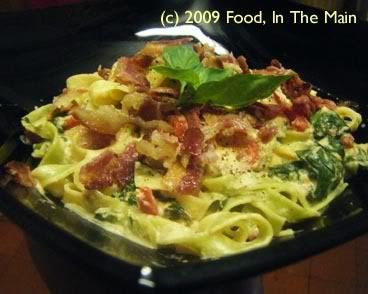skip to main |
skip to sidebar
This post is dedicated to a dear blogger whose every post reflects her sincerity and sweetness - Linda OutOfTheGarden(AndLatelyByTheLake). If it hadn't been for her timely rant, you wouldn't be reading this - because there wouldn't have been anything to read. Oh by the way, do read her rant - you'd be hard pressed to find a gentler, sweeter one! When I rant, I rant; when Linda rants... well, she's as likable as ever!
About this recipe, it was meant to be mild and mostly monochrome (white turnip, white pasta, white onion, white mushrooms) but I decided to greenify it a bit by adding spinach and rocket (love the stuff) and a tiny touch of red and heat by way of a fresh red chilli - and then some crunch in the form of pine nuts... and pretty soon it wasn't the original recipe any more. It was better (she said humbly).
Recipe for: Farfalline with turnip, mushrooms and greens
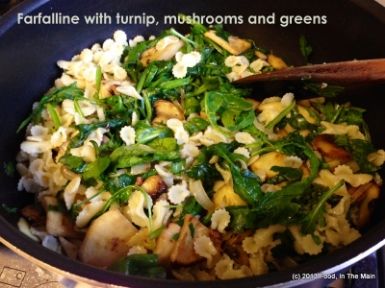
Ingredients:
1/2 cup farfalline or orzo pasta
1 medium turnip, peeled and sliced about 1/4 cm thick and each slice quartered
1 small onion or 2 banana shallots, chopped fine
1/3 cup chestnut mushrooms, sliced
Good handful of spinach leaves, torn
Good handful of rocket leaves
1 red chilli, minced very fine (optional)
1 fat clove garlic, sliced
1 tsp butter
2 tsp olive oil
Salt and pepper to taste
2 tbsp basil and parsley, sliced
1 tbsp toasted pine nuts, for garnish
Method:
1. Cook the orzo/farfalline according to directions in plenty of boiling salted water. Drain, toss with a little olive oil and set aside.
2. Heat 1 tsp oil in a pan and add the garlic, chillies and shallots and stir. Cook over medium heat until the shallots are soft and light brown. Remove from the pan and set aside.
3. In the same pan, heat the remaining oil and butter, add the sliced turnip and mushrooms. Fry until they're golden brown, about 7-8 minutes.

4. Add the cooked shallots to the pan and mix them in. Toss in the spinach and rocket, then stir in the cooked pasta. Add salt and pepper to taste. Stir in the basil and parsley, scatter over the pine nuts, and serve hot or at room temperature.
I kind of gave myself a rather big shock yesterday. Like 9.8 on the Richter scale level of shock.
Determined to use an aubergine which I'd bought with the intention of making something for Pete (my dislike of this vegetable in ANY form is well documented, so I won't harp on it), I'd settled on aubergine parmigiana (actually called melanzane parmigiana on the BBC website where I saw this recipe). I'd done the prepping and pan-fried the sliced aubergine and made the tomato sauce and had even finished placing the aubergine-tomato sauce-mozzarella layers in the baking dish, ready for baking, when I realised something.
Well, two things, actually.
One, it was a vegetarian recipe, therefore fit to appear on my blog (never mind that nothing short of prolonged starvation would make me eat the stuff!).
Two, I'd not taken any photographs!!!
I think it was realisation No 2 that really gave me a jolt. I mean, for the last few years my camera has been as much part of my kitchen equipment as anything else... it's been splashed with sauces and dunked into flour and put away with the fruit (note that none of these and other such incidents were on purpose) and generally suffered for my "step-by-step" photos of recipes being made. I've been pretty consistent - and a tad obsessive - about taking those photos... and yet there I was, food blog forgotten and with no idea of the whereabouts of my poor abused camera.
Yep, 9.8 on the Richter scale, folks. Anyway, that's the reason for the very few photos in this post.
And yeah, I've made a mental note to neglect my food blog a little less... it's been around a while, possibly the longest I've kept something going, and with some luck and effort on my part, and plenty of encouraging visits from all you lovely foodies out there (hint, hint), this blog will keep going for a while longer yet!
As regards this particular recipe, I've no idea how it tastes. My husband was reasonably encouraging, merely remarking that perhaps the addition of some sliced portabello mushrooms layered with the aubergine would have imparted their umami flavour and made it taste less "vegetable-y" (and there speaks the carnivore!). But he liked it as it was, and said he would eat it if I made it again. That'll do me. The mushroom addition experiment will have to wait till the next time I make this.
Recipe for: Aubergine parmigiana
 Ingredients:
1 medium aubergine/eggplant/kathirikkai
1-1/2 cups chopped ripe tomatoes
2 tbsp sliced black olives (I used canned)
150 gm mozzarella, sliced
1/2 cup fresh basil, shredded
1 tbsp olive oil plus more for brushing
1/2 tsp cinnamon powder
2-3 cloves garlic, sliced thin
salt and pepper to taste
2-3 tbsp parmesan
Ingredients:
1 medium aubergine/eggplant/kathirikkai
1-1/2 cups chopped ripe tomatoes
2 tbsp sliced black olives (I used canned)
150 gm mozzarella, sliced
1/2 cup fresh basil, shredded
1 tbsp olive oil plus more for brushing
1/2 tsp cinnamon powder
2-3 cloves garlic, sliced thin
salt and pepper to taste
2-3 tbsp parmesan
Method:
1. Slice the aubergine vertically into 1/2 cm slices. (You can sale them, place them in the colander with a heavy weight on top to let the bitterness out, but I didn't bother with this step.)
2. Brush both sides of each slice with some oil.
3. Heat 1 tbsp oil in a pan and add the garlic, frying on medium heat until they are soft and fragrant. Then add the tomatoes, olives and cinnamon. Let the sauce simmer for 10-15 minutes, giving it a stir now and then, until the tomatoes are soft and mushy.
4. While the sauce is cooking away, heat a large frying pan or griddle. Fry the oiled aubergine slices in batches, without crowding, on both sides till they are light brown and soft.
5. When the aubergine slices are cooked, place a layer of the prepared tomato sauce in a small oven-proof casserole dish.
6. Now place a layer of aubergine on top of the sauce, then a layer of mozzarella slices and a sprinkling of shredded basil. Season the layer with freshly ground pepper and salt.
7. Continue the layers in the same order, topping it off with a layer of tomato sauce and another sprinkling of basil.
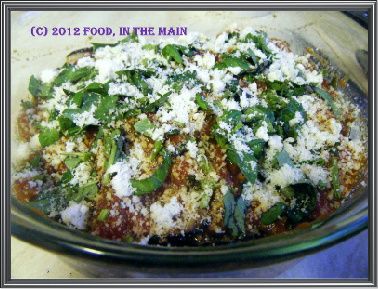 8. Sprinkle the parmesan cheese over the top
8. Sprinkle the parmesan cheese over the top
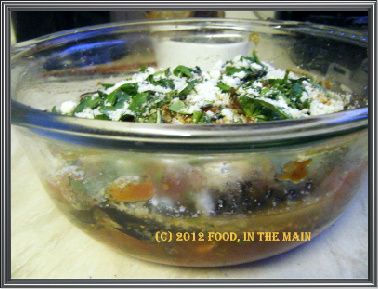 and bake at 160C for 30-40 minutes, till the sauce is bubbly and the top is golden brown.
9. Let the dish rest for 5 minutes or so, then serve up the aubergine parmigiana with crusty buttered bread and a green salad.
and bake at 160C for 30-40 minutes, till the sauce is bubbly and the top is golden brown.
9. Let the dish rest for 5 minutes or so, then serve up the aubergine parmigiana with crusty buttered bread and a green salad.
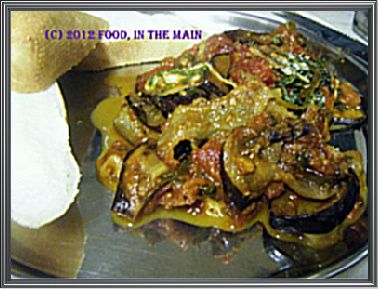 RECIPE: AUBERGINE PARMIGIANA
Ingredients:
1 medium aubergine/eggplant/kathirikkai
1-1/2 cups chopped tomatoes
2 tbsp sliced black olives (I used canned)
150 gm mozzarella, sliced
1/2 cup fresh basil, shredded
1 tbsp olive oil plus more for brushing
1/2 tsp cinnamon powder
2-3 cloves garlic, sliced thin
salt and pepper to taste
2-3 tbsp parmesan
RECIPE: AUBERGINE PARMIGIANA
Ingredients:
1 medium aubergine/eggplant/kathirikkai
1-1/2 cups chopped tomatoes
2 tbsp sliced black olives (I used canned)
150 gm mozzarella, sliced
1/2 cup fresh basil, shredded
1 tbsp olive oil plus more for brushing
1/2 tsp cinnamon powder
2-3 cloves garlic, sliced thin
salt and pepper to taste
2-3 tbsp parmesan
Method:
1. Slice the aubergine vertically into 1/2 cm slices. (You can sale them, place them in the colander with a heavy weight on top to let the bitterness out, but I didn't bother with this step.)
2. Brush both sides of each slice with some oil.
3. Heat 1 tbsp oil in a pan and add the garlic, frying on medium heat until they are soft and fragrant. Then add the tomatoes, olives and cinnamon. Let the sauce simmer for 10-15 minutes, giving it a stir now and then, until the tomatoes are soft and mushy.
4. While the sauce is cooking away, heat a large frying pan or griddle. Fry the oiled aubergine slices in batches, without crowding, on both sides till they are light brown and soft.
5. When the aubergine slices are cooked, place a layer of the prepared tomato sauce in a small oven-proof casserole dish.
6. Now place a layer of aubergine on top of the sauce, then a layer of mozzarella slices and a sprinkling of shredded basil. Season the layer with freshly ground pepper and salt.
7. Continue the layers in the same order, topping it off with a layer of tomato sauce and another sprinkling of basil.
8. Sprinkle the parmesan cheese over the top and bake at 160C for 30-40 minutes, till the sauce is bubbly and the top is golden brown.
9. Let the dish rest for 5 minutes or so, then serve up the aubergine parmigiana with crusty buttered bread and a green salad.
It started with two boiled potatoes. They were left over because I'd cooked too many. I had cooked too many because the potatoes were pretty elderly and showing signs of wanting to procreate, and I didn't want to waste them.
The thing was, I didn't really know what to make with the leftover potatoes. I didn't want to make the usual tikkis or bondas - apart from being boring, they weren't suitable for the food blog (because they'd already been featured some time ago).
The box grater was on the kitchen counter, and absent-mindedly I grated the potatoes. Now there was a pile of somewhat gooey grated potatoes - and no real clue what to do with it.
So I peeled an onion and chopped it. Now I had: 1. A pile of grated cooked potatoes and 2. A chopped onion. Only one thing to do thereafter, so I heated up a tsp of oil and part cooked the onion. Some spinach caught my eye and I added that in, then the potatoes, and mixed it all up with a bunch of herbs that I've got growing (basil, thyme and rosemary) on the windowsill. And I also added salt and lots of freshly milled black pepper.
It was beginning to look like tikkis were going to happen, whether I wanted it or not.
Luckily, Pete came in just then, sniffing the air because the potato mixture smelt really rather nice. He tasted the mixture and decided to improve it by adding some parmesan cheese. He tasted it again and said that there was something still missing... and that something turned out to be mustard.
Mustard loves cheese in some mysterious way, sharpening its edges and making the cheese cheesier rather than mustard-y. It's a strange alchemy that I absolutely do not want explained in any scientific manner - it's enough for me that the mustard and cheese love each other. (Food engineers please take note.) And by the way, mustard in a cauliflower-cheese bake is fabulously good!
But we're not discussing cauliflower-cheese bake in this post, so I will desist. So, back to what I was saying... at that point, I suddenly remembered the block of puff pastry in the fridge. And just like that, the fate of the potato-cheese was decided. Not tikkis, but potato-cheese puffs. What a brilliant idea that turned out to be! Of course the parmesan alone wasnt enough, so some mature Cheddar was invited to the puff party.
Ok, I didn't make the puff pastry from scratch. Sure, the shop-bought stuff has some preservatives in it, but I buy it so rarely that I figure it's not going to make that much difference to the temple of holiness that our bodies are supposed to be. I like cooking, but making puff pastry from scratch... no, I don't think so. Life is too short.
Anyway, the puffs were absolutely lovely - not TOO cheesy, but beautifully savoury. And filling, too.
Recipe for: Spinach-potato-cheese puffs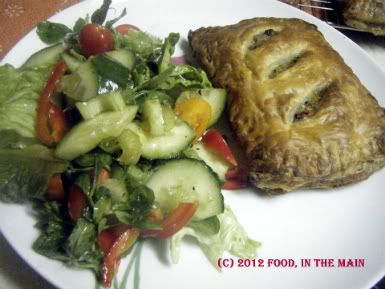
Ingredients:
1 pack shop-bought puff pastry
2 large potatoes, boiled and grated
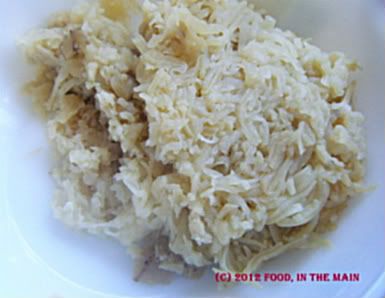
1 cup spinach leaves, sliced or torn up
1 medium onion, chopped
2 tbsp fresh herbs (thyme, basil, rosemary), chopped
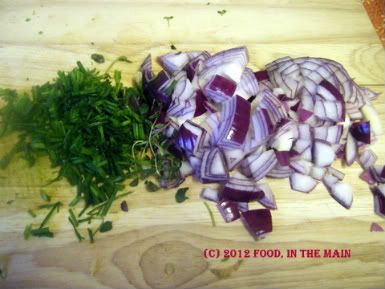
3 tbsp grated parmesan
1/2 cup cheddar cheese, cut into small cubes
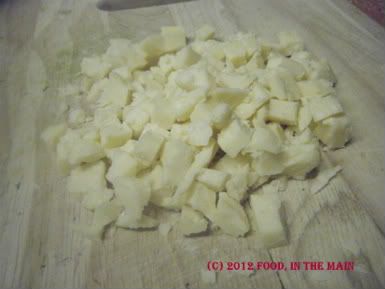
1 tsp medium curry powder
1 htsp Dijon mustard
1 tsp oil
Salt and pepper to taste
Method:
1. Heat the oil in a pan and add the chopped onions and herbs.
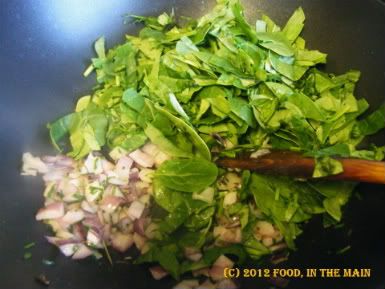
2. When the onions begin to soften (about a minute or so), add the spinach leaves.

3. Stir-fry the spinach till it's just wilted, then add the grated potatoes.
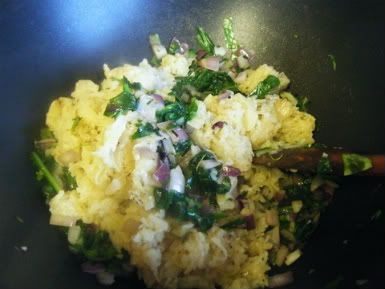
4. Mix with a light hand till the spinach is evenly distributed.
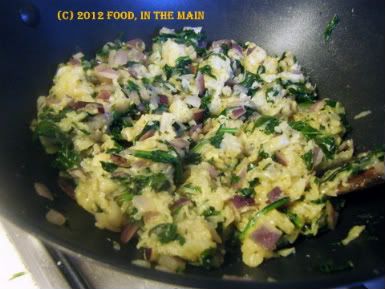
5. Turn off the heat and let the potato mixture cool. Once cool, mix in the parmesan cheese, salt and pepper to taste, the mustard and the curry powder.
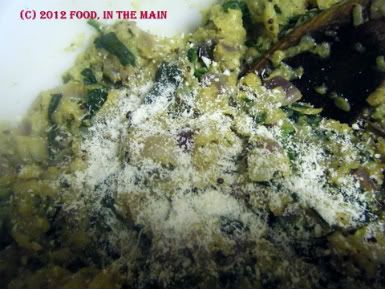
6. Finally, add the cubed cheddar to the mixture. Reserve till required.
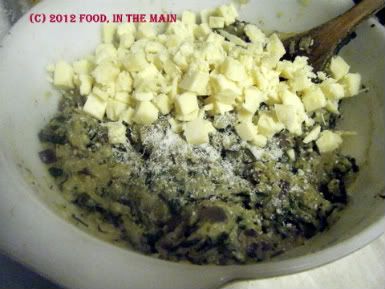
7. Now, roll the puff pastry into a rectangle. Cut it into four or five strips, depending on what size you want the puffs to be, then cut the strips in half again. Place 2-3 tbsp of the filling on one half, spreading it out to within 1/2 cm of the edges.
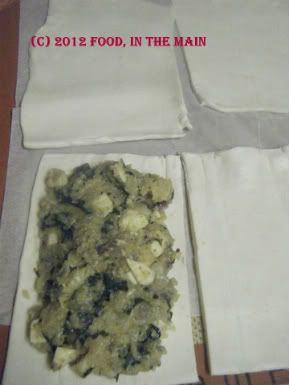
8. Place the other half of the strip over the filling and ensure that the filling is fully encased. Crimp the edges of the pastry to stop the filling from leaking. Use the remaining dough and filling in the same way. Make two or three slashes across the top of each puff with a sharp knife - this will make it look pretty when finished.
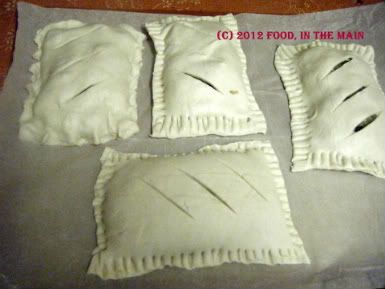
9. Bake the puffs in a hot oven (180C/350F) until they are golden brown and cooked.
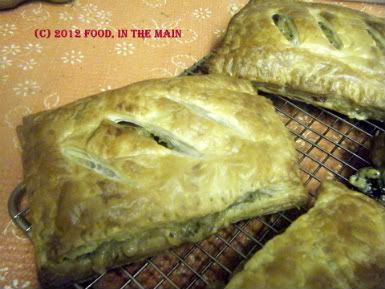
10. Serve warm with a salad.
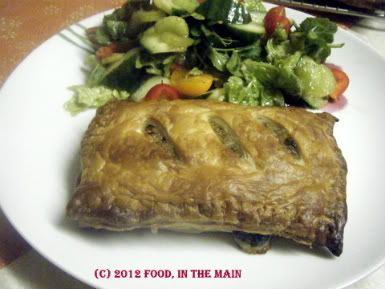
RECIPE: SPINACH-POTATO-CHEESE PUFFS
Ingredients
1 pack shop-bought puff pastry
2 medium potatoes, boiled and grated
1 cup spinach leaves, sliced or torn up
1 medium onion, chopped
2 tbsp fresh herbs (thyme, basil, rosemary), chopped
3 tbsp grated parmesan
1/2 cup cheddar cheese, cut into small cubes
1 tsp medium curry powder
1 htsp Dijon mustard
1 tsp oil
Salt and pepper to taste
Method
1. Heat the oil in a pan and add the chopped onions and herbs.
2. When the onions begin to soften (about a minute or so), add the spinach leaves.
3. Stir-fry the spinach till it's just wilted, then add the grated potatoes.
4. Mix with a light hand till the spinach is evenly distributed.
5. Turn off the heat and let the potato mixture cool. Once cool, mix in the parmesan cheese, salt and pepper to taste, the mustard and the curry powder.
6. Finally, add the cubed cheddar to the mixture. Reserve till required.
7. Now, roll the puff pastry into a rectangle. Cut it into four or five strips, depending on what size you want the puffs to be, then cut the strips in half again. Place 2-3 tbsp of the filling on one half, spreading it out to within 1/2 cm of the edges.
8. Place the other half of the strip over the filling and ensure that the filling is fully encased. Crimp the edges of the pastry to stop the filling from leaking. Use the remaining dough and filling in the same way. Make two or three slashes across the top of each puff with a sharp knife - this will make it look pretty when finished.
9. Bake the puffs in a hot oven (180C/350F) until they are golden brown and cooked.
10. Serve warm with a salad. Spinach-potato-cheese puffs
What does the term "salad" mean to you? Something with green leaves, tomatoes and cucumber and radishes, perhaps with a dressing? That's what denotes a salad to me - even now, when I know that practically anything can be a "salad".
I have to say it used to puzzle me. What is pasta salad, anyway? Or - a very strange thing to a South Indian - rice salad? Could South Indian lemon rice or tamarind rice be classified as rice salad?
I'm still not entirely sure why something that is not a salad when hot becomes a salad when cold. Examples? Well, pasta. Eat it cold, and it's a pasta salad. Eat it hot, and it's... well, pasta. Rice, too, undergoes that transition - especially if there's wild rice in there. Take couscous, too. Pizza Hut has cold couscous in its salad bar. When is couscous a side dish, and when is it a salad? More to the point, why is it a salad when it's cold? And then those hot salads - how do THOSE come about without becoming not-salad?
I don't mean any disrespect to the West when I say that perhaps everything is a "salad" here because they don't know how else to classify the various cooked foods from other cultures? What do you think?
This recipe could be a salad, or not. It could be a side dish. Or merely a form of couscous upma. Here's a thought - perhaps we Southies call everything "upma" because salads aren't really in our culinary heritage?
Because I don't know what to call my recipe - salad, side dish, upma, whatever - I'm terming it "couscous with lentils". At least it has the virtue of literalness.
Recipe for: Couscous with lentils
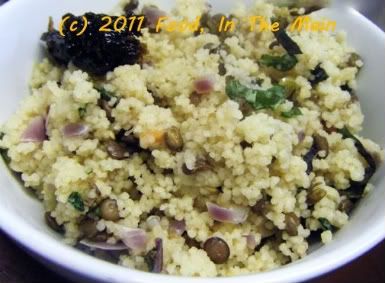 Ingredients:
1/4 cup green lentils
1 bay leaf
1 cup couscous
1 red onion, chopped finely
2 green chillies, chopped
Ingredients:
1/4 cup green lentils
1 bay leaf
1 cup couscous
1 red onion, chopped finely
2 green chillies, chopped
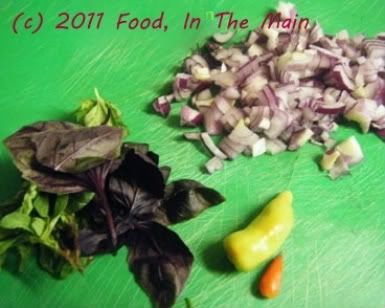 1 small tomato, chopped
2 cloves garlic, minced
a handful of fresh basil leaves
Salt and pepper to taste
about 1-1/2 cups vegetable stock (or water)
1 tsp oil
Method:
1. Cook the lentils in salted water along with the bay leaf, till they're cooked but not mushy.
1 small tomato, chopped
2 cloves garlic, minced
a handful of fresh basil leaves
Salt and pepper to taste
about 1-1/2 cups vegetable stock (or water)
1 tsp oil
Method:
1. Cook the lentils in salted water along with the bay leaf, till they're cooked but not mushy.
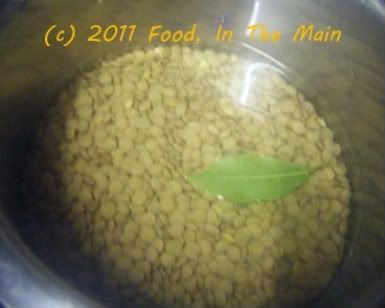 Drain and reserve.
Drain and reserve.
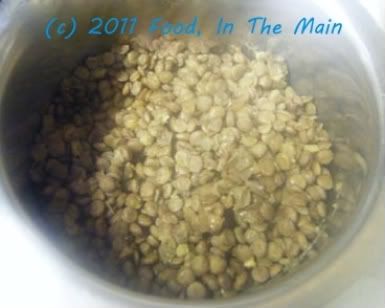 2. In a medium size pan, heat the oil and add the chopped chillies, garlic and red onion. Stir well.
2. In a medium size pan, heat the oil and add the chopped chillies, garlic and red onion. Stir well.
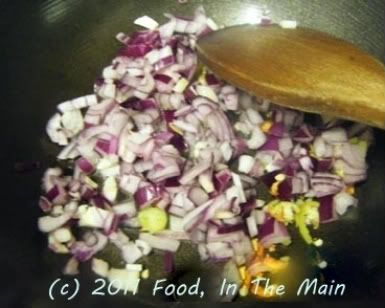 3. Let the onions soften a little, then add the chopped tomato.
3. Let the onions soften a little, then add the chopped tomato.
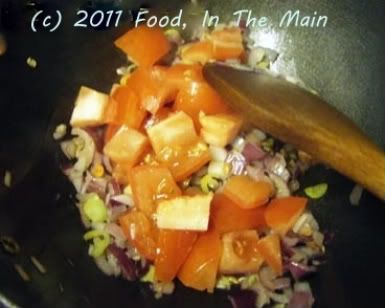 4. Once the tomatoes are beginning to break down, pour in the stock and bring to a brisk boil.
4. Once the tomatoes are beginning to break down, pour in the stock and bring to a brisk boil.
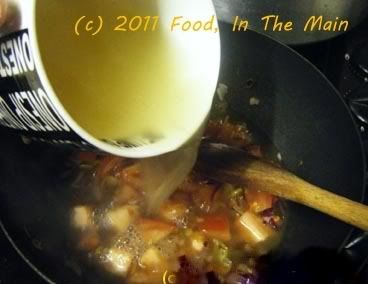 5. Now add the couscous and stir it well. Add salt to taste and bring back to the boil.
5. Now add the couscous and stir it well. Add salt to taste and bring back to the boil.
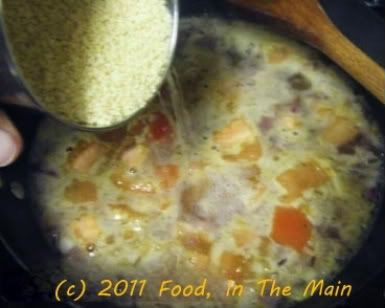 6. Turn off the heat and cover the pan with a well-fitting lid. Let the couscous rest for 10-15 minutes.
7. Once all the water has been absorbed, fluff up the couscous with a fork. Add the reserved lentils and freshly ground pepper to taste, and toss to mix, or fork it through to mix.
6. Turn off the heat and cover the pan with a well-fitting lid. Let the couscous rest for 10-15 minutes.
7. Once all the water has been absorbed, fluff up the couscous with a fork. Add the reserved lentils and freshly ground pepper to taste, and toss to mix, or fork it through to mix.
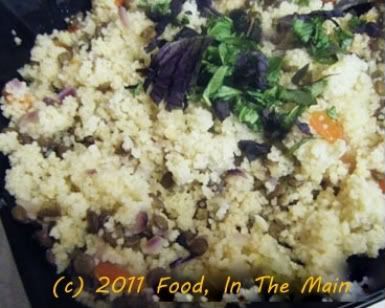 8. Garnish generously with shredded basil leaves and serve the couscous warm as a side with lamb dishes, or as a snack.
RECIPE: COUSCOUS WITH LENTILS
Ingredients:
1/4 cup green lentils
1 bay leaf
1 cup couscous
1 red onion, chopped finely
2 green chillies, chopped
1 small tomato, chopped
2 cloves garlic, minced
a handful of fresh basil leaves
Salt and pepper to taste
about 1-1/2 cups vegetable stock (or water)
1 tsp oil
Method:
1. Cook the lentils in salted water along with the bay leaf, till they're cooked but not mushy. Drain and reserve.
2. In a medium size pan, heat the oil and add the chopped chillies, garlic and red onion. Stir well.
3. Let the onions soften a little, then add the chopped tomato.
4. Once the tomatoes are beginning to break down, pour in the stock and bring to a brisk boil.
5. Now add the couscous and stir it well. Add salt to taste and bring back to the boil.
6. Turn off the heat and cover the pan with a well-fitting lid. Let the couscous rest for 10-15 minutes.
7. Once all the water has been absorbed, fluff up the couscous with a large fork. Add the reserved lentils and freshly ground pepper to taste, and toss to mix, or fork it through to mix.
8. Garnish generously with shredded basil leaves and serve the couscous warm as a side dish with meat dishes, or as a snack.
8. Garnish generously with shredded basil leaves and serve the couscous warm as a side with lamb dishes, or as a snack.
RECIPE: COUSCOUS WITH LENTILS
Ingredients:
1/4 cup green lentils
1 bay leaf
1 cup couscous
1 red onion, chopped finely
2 green chillies, chopped
1 small tomato, chopped
2 cloves garlic, minced
a handful of fresh basil leaves
Salt and pepper to taste
about 1-1/2 cups vegetable stock (or water)
1 tsp oil
Method:
1. Cook the lentils in salted water along with the bay leaf, till they're cooked but not mushy. Drain and reserve.
2. In a medium size pan, heat the oil and add the chopped chillies, garlic and red onion. Stir well.
3. Let the onions soften a little, then add the chopped tomato.
4. Once the tomatoes are beginning to break down, pour in the stock and bring to a brisk boil.
5. Now add the couscous and stir it well. Add salt to taste and bring back to the boil.
6. Turn off the heat and cover the pan with a well-fitting lid. Let the couscous rest for 10-15 minutes.
7. Once all the water has been absorbed, fluff up the couscous with a large fork. Add the reserved lentils and freshly ground pepper to taste, and toss to mix, or fork it through to mix.
8. Garnish generously with shredded basil leaves and serve the couscous warm as a side dish with meat dishes, or as a snack.
When I was new to pasta and found out that there were all sorts of different shapes available, I used to imagine that they would all taste different as well, perhaps because of being made from different things (in keeping with the varied shapes). I didn’t realise then that the pasta shapes were made with different styles of sauces in mind – thick and meaty sauces would need large shapes that would hold the sauce, pasta salads would only require small shapes with no "holding" characteristics and so on.
So when a more world-cuisine-savvy friend of mine pointed out that all pasta, no matter the shape or size, were made from durum wheat (with minor variations like the addition of egg or spinach), I was terribly disappointed.
“You mean they all have different names and look different but are made from the same ingredients?" I asked disbelievingly."Yes," he said, uncompromisingly. "Are you quite sure? They're all made from the same ingredients?” I asked for the second time in as many minutes, unwilling to let go of my illusion that each had its own taste.
“Yes, quite sure,” he said again, unable to figure out why I sounded so let-down.
I persisted with my questioning even in the face of his blunt reply. “Then they all taste the same? Just the sauces are different? All the cooked pasta have the same bland taste?"
“YES,” he said, again uncompromisingly but this time with an added edge of irritation.
“But then what’s the POINT?” I wailed.
“What do you mean, what’s the point?” Full-on exasperation, there.
“What’s the POINT of having different shapes if it’s all just the same damn thing? What’s the big deal about pasta then? It’s really the sauce that matters, not the pasta itself.”
And that was when I got the lecture about diff’rent strokes for diff’rent folks, to use a phrase not coined by me in a context probably totally unlike the original coining.
Although I eventually learnt to accept that all pasta may just be pasta but none of them are JUST pasta, still in my heart of hearts there lingers the faint echo of my original outburst... “But what’s the big deal about pasta, then?”
On the other hand, I’ve had people say to me, on being informed that South Indian cuisine is based predominantly around rice with different “sauces” (sambar, rasam, kootu, etc) to flavour it: “But rice is just like pasta then, isn’t it?”
It has been only with the greatest reluctance that I could bring myself to admit that yes, in that ONE way rice IS like pasta... but it’s also so very much MORE than pasta! Different varieties of rice, when cooked, taste and smell different and have different textures. I’m guessing that it’s only of late that scientists have been “inventing” new varieties of rice – but even that is only reinvention (using Nature’s bounty) at best, or tampering (with Nature’s bounty) at worst.
Pasta, on the other hand, completely an artificial invention (seen any pasta fields lately, folks?), has no distinguishing natural characteristics by way of shape or size (beyond those created by humans) or taste (beyond the “taste” of the sauce in which it is dunked).
So, bottomline - no, pasta is most definitely not like rice.
However, over the years, I’ve quite learnt to like pasta and I do understand about the shapes and sizes and uses.
Here’s a recipe with one of each – size, shape and use.
Recipe for: Pasta with rocket (arugula) pesto
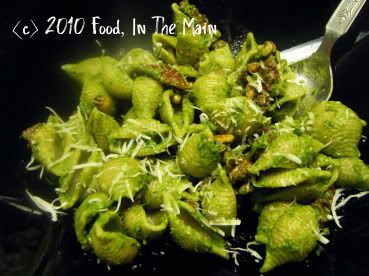
Ingredients:
Whole-wheat pasta - orecchiette or conchigliette for choice, but penne or farfalle will do
4 cups rocket (arugula), washed and patted dry
1/4 cup fresh basil leaves
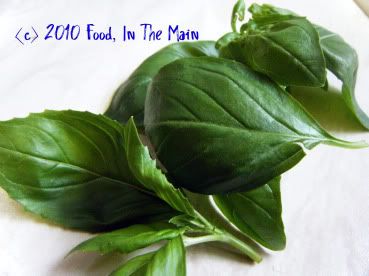
3-4 cloves of garlic
1 tbsp fresh lemon juice
3/4 cup pine nuts (can substitute walnuts)
About 1/4 cup good quality extra virgin olive oil
1/3 cup sundried tomatoes in oil, well drained
Salt and pepper to taste
Grated or shaved Parmigiano reggiano for garnish
Method:
1. Toast the pine nuts in a skillet till golden brown, taking care not to burn them. Set aside to cool.
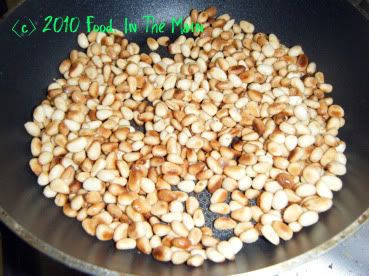
2. In a food processor or mixie, add half the toasted pine nuts (reserving the other half), garlic, rocket (arugula) leaves and basil. Squeeze or pour the lemon juice over the leaves.
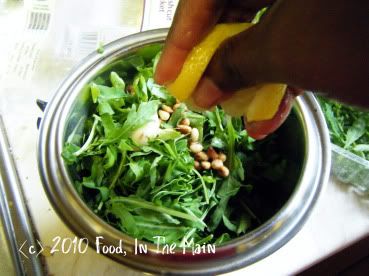
3. Now add olive oil little by little, as required, to help grind the leaves and nuts smoothly.
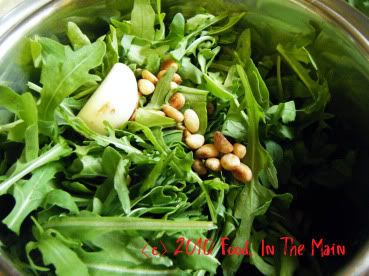
You might not need to use all the olive oil, just use as much as required.
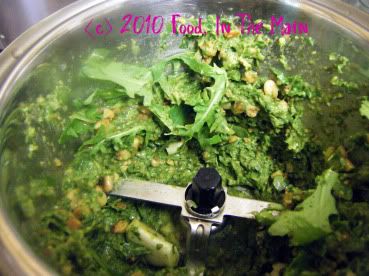
4. When the ingredients have been ground up into a fairly smooth pesto, remove the pesto to a bowl.

5. Add plenty of pepper and salt to taste.
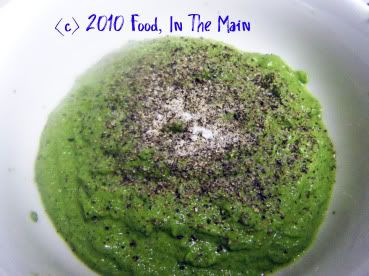
6. Cook the pasta till al dente in plenty of salted water, and drain off the water when the pasta is done. Return the pasta to the pan.
7. Slice the drained sundried tomatoes thinly.

8. Add 3-4 tbsp of the pesto to the pasta and mix in thoroughly. Taste for seasoning and add more pesto if required, making sure that every bit of the pasta is covered.
Add the sliced sundried tomatoes and stir them in,
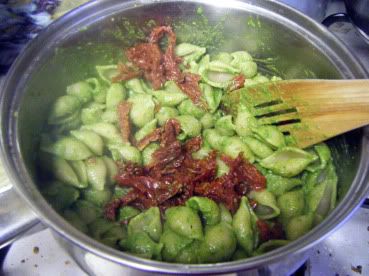
then add the reserved toasted pine nuts. Toss or stir the pasta to distribute the pine nuts evenly.
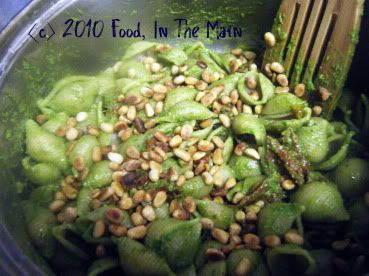
9. Serve the pasta in warmed bowls with generous shavings or gratings of parmigiano reggiano as garnish.
I'm not a great fan of cheesy pasta recipes - there's really only so much cheese I can take before my taste buds put their hands up in the air and beg for mercy. Cheese is something I can take on board only in small amounts - VERY small amounts. This applies to any cheese that has a pronounced flavour - cheddar, parmesan, feta, halloumi, whatever. Paneer doesnt figure on this list because it doesn't have a definite taste. And blue cheeses don't count as food, as far as I'm concerned... unless they're classified as "food that was once alive but is now putrefied". So, as far as pasta goes, my preference is for tomato-based sauces. I don't mind cream cheese, as long as it's mixed with herbs... and a recipe for a pasta sauce that combined tomatoes and cream cheese seemed doable. I would have added chillies, or possibly chilli sauce to the recipe, but since this was to be a quick-fix dinner for me and Pete, I had to keep the hot stuff at bay. The sauce was, as I'd suspected it would be, very nice with the flavour of tomatoes melding nicely with the cream cheese. I added lots of fresh basil (two types, both home grown, yay!), and a topping of crisp crumbled bacon for Pete and sort of crisp, crumbled facon (= fake bacon, or bacon-style strips) for me; and with a bottle of wine on the side, the pasta made a very pleasant meal. Recipe for: Tomato cream cheese pasta
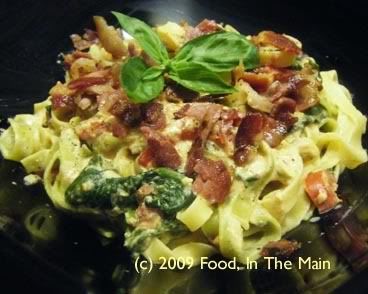
Ingredients:
Wide egg noodles for two (approx 75 gm uncooked per person)
2-3 medium tomatoes
3-4 cloves garlic, chopped
1 small red pepper, deseeded and sliced
2 cups fresh spinach leaves
4 tbsp non-fat garlic-and-herb flavour cream cheese (or plain will do as well)
1/4 cup basil leaves, shredded
Salt and pepper to taste
2 tsp olive oil
2-3 strips bacon (or facon), cooked crisp and crumbled, for garnish
Method:
1. Put the pasta/noodles on to boil as per directions on the pack.
Quarter the tomatoes, then puree smooth.
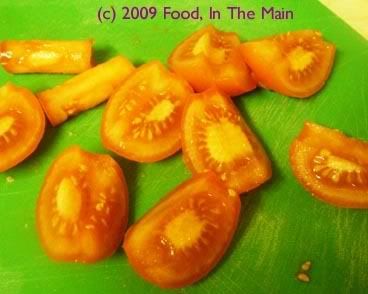
2. Fry the garlic in the olive oil till just soft, but not brown.
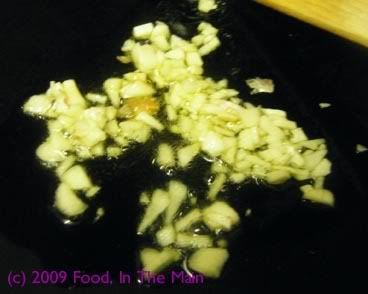
3. Add the sliced peppers.
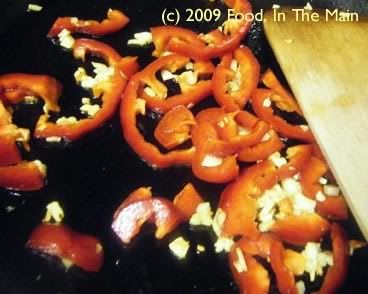
4. Then add the spinach leaves,
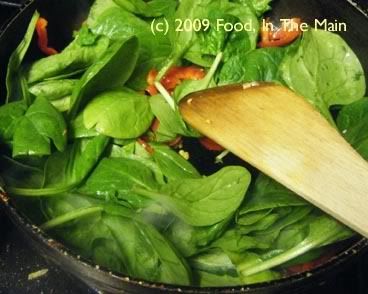
and stir till the leaves wilt and the pepper just begins to soften.
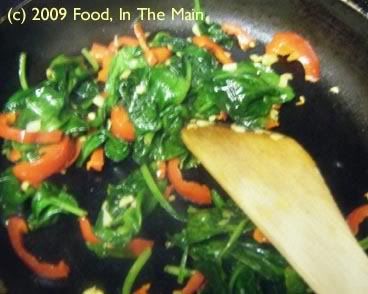
5. Add the cream cheese to the pureed tomato.

6. Whisk them well to form a sauce.
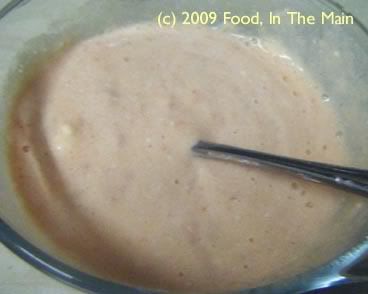
7. Add the cream-cheese tomato sauce to the pan with the vegetables and stir it in. Add salt and freshly ground black pepper to taste.
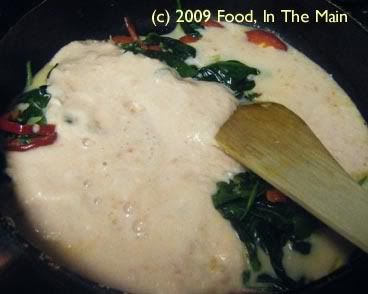
8. Stir in the chopped basil.
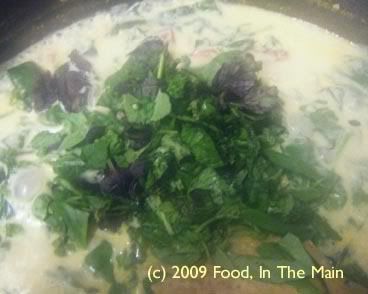
9. Drain the cooked pasta and add the pasta to the pan.
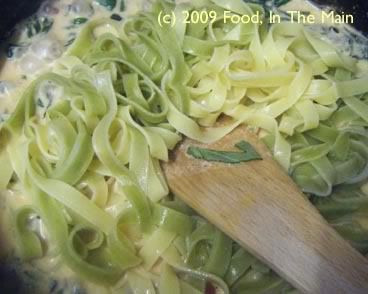
10. Gently mix it with the sauce and heat thoroughly but do not let it boil.
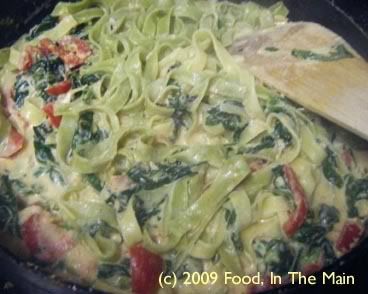
11. Serve in warm bowls with the crumbled bacon/facon on top as garnish and some fresh basil leaves.
